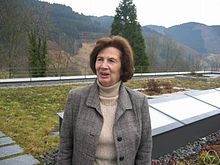Vera T. Sós

Vera Turán Sós (born September 11, 1930 in Budapest ) is a Hungarian mathematician who mainly deals with graph theory , combinatorics and number theory.
biography
After graduating from grammar school, where she was taught by Tibor Gallai , Sós studied at Loránd Eötvös University with Paul Erdős and Alfréd Rényi , with whom she also worked closely. After her habilitation, she was a professor at the University of Budapest and since 1987 she has been a research professor at the Institute for Mathematics of the Hungarian Academy of Sciences (Alfréd-Rényi-Institut). Vera Sós was married to the mathematician Pál Turán (1910–1976) since 1952 , with whom she has two children.
In 1957 she proved the “three-distance theorem” according to a conjecture by Hugo Steinhaus : Consider the first integer multiples of an irrational number mod 1. The sections of the route formed by the points in the unit interval have at most three different lengths.
László Babai (1975, together with Pál Turán) is one of her doctoral students . In 2002 she and others edited a selection of Paul Erdős' works.
In 1985 she became a corresponding and in 1990 a full member of the Hungarian Academy of Sciences. She is a corresponding member of the Austrian Academy of Sciences . In 2013 she was elected a member of the Academia Europaea .
literature
G. Halász, László Lovász , D. Miklós, T. Sónyi (editors): Sets, Graphs and Numbers - a birthday salute to Vera T. Sos and Andras Hajnal . Elsevier 1992.
Fonts
- Editor with Paul Erdős , Alfréd Rényi : Combinatorial theory and its Applications. North Holland 1970 (Conference in Budapest August 1969).
- Editor with László Lovász: Algebraic methods in graph theory. North Holland 1981.
- Editor with Ervin Győri: Recent trends in Combinatorics - the legacy of Paul Erdős. Cambridge University Press 2001.
Web links
- Hungarian newspaper report on the occasion of his 75th birthday
- Interview, Hungarian
- László Lovász on Vera Sós (Dutch, PDF).
References
- ↑ Together they proved the “friendship theorem”: If two nodes in a finite graph have exactly one neighbor in common, there is one node that is connected to all the others.
- ^ Sós in Acta Math. Acad. Sci. Hung. Vol. 8, 1957, p. 461, Ann. Univ. Sci. Budapest Sect. Math., Vol. 1, 1958, pp. 127-134. Discussed in Donald Knuth : The Art of Computer Programming. Vol. 3, 1973, p. 511, with the proof as an exercise on p. 543 (Knuth's difficulty rating M 34, i.e. on the logarithmic scale between M 30 (two hours) and M 40 (semester project))
- ↑ Demonstration of the theorem at Wolfram Research
| personal data | |
|---|---|
| SURNAME | Sós, Vera T. |
| ALTERNATIVE NAMES | Sós, Vera Turán (full name) |
| BRIEF DESCRIPTION | Hungarian mathematician |
| DATE OF BIRTH | September 11, 1930 |
| PLACE OF BIRTH | Budapest |

